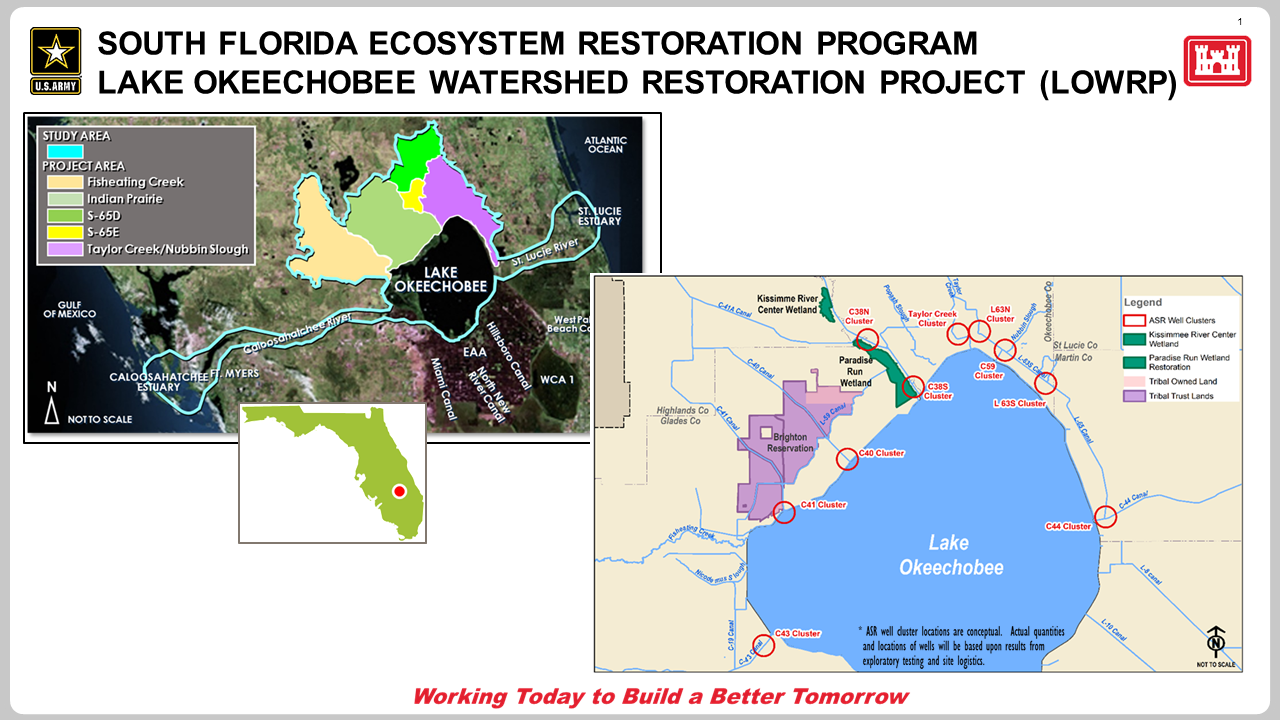May 2025
FACT SHEET
COMPREHENSIVE EVERGLADES RESTORATION PLAN
Lake Okeechobee Watershed Restoration Project
Planning (P)
Congressional Districts: 17, 18, 19, 20, 21, 22, 23, 24, 25, 26, 27, 28
1. DESCRIPTION
Published in 1998, the Central and Southern Florida Comprehensive Review Study Final Integrated Feasibility Report and Programmatic Environmental Impact Statement (the “Yellow Book”) provides the blueprint for how water quantity, quality, timing, and distribution challenges in the south Florida ecosystem are to be addressed. The Yellow Book organizes the work to be conducted into 68 components. As scoped, three of those components associated with water storage north of Lake Okeechobee are included in the Lake Okeechobee Watershed Restoration Project (LOWRP):
- Component A: North of Lake Okeechobee Storage Reservoir.
- Component GG: Lake Okeechobee Aquifer Storage and Recovery.
- Component OPE: Wetland Restoration (Lake Okeechobee Watershed Water Quality Treatment Facilities).
2. FUNDING
| Estimated Total Cost |
$9,757,000 |
| Estimated Federal Cost |
$6,754,000 |
| Allocation thru FY24 |
$6,430,000 |
| Allocation for FY25 |
$0 |
| President’s Budget FY26 |
$0 |
3. SPONSOR
South Florida Water Management District (SFWMD)
3301 Gun Club Road
West Palm Beach, Florida 33406
4. STATUS
a. Planning on the Lake Okeechobee Watershed Restoration Project (LOWRP) was initiated in the early 2000s but halted in 2006. The project was re-scoped under the USACE SMART (3x3) planning paradigm with a new set of alternatives to be analyzed in 2016.
b. A waiver to the SMART (3X3) rule increasing the budget of the effort from $3M to $5.7M was approved in 2018. The Tentatively Selected Plan (TSP) developed in 2018 included four components:, a 12,500-acre shallow reservoir with a total storage capacity of 43,000 acre-feet (aka Water Attenuation Feature [WAF]), a series of 80 Aquifer Storage and Recovery (ASR) wells adjacent to Lake Okeechobee and co-located with the WAF, and two wetland restoration features at Paradise Run (4100-acre) and Kissimmee River Center (1200-acre).
c. A draft Project Implementation Report/Environmental Impact Statement (PIR/ EIS) package was released for agency and public review in July 2018. A second exemption to the SMART (3X3) rule was approved in June 2019, increasing the duration of the study from 36 to 46 months and the budget by $800K.
d. The Final PIR/EIS was published, and a Chief’s Report was released for State & Agency review in August 2020. Concerns brought forward by stakeholders related to acceptability of above ground storage sited directly upstream from a community and adjacent to the Seminole Tribe of Florida Brighton Reservation and the high cost per acre-foot of shallow above ground storage warranted a change to the Recommended Plan.
e. Coordination with South Atlantic Division (SAD) and USACE Headquarters (HQ USACE) resulted in removal of the WAF and its 25 WAF-assisted ASR wells to create a revised Recommended Plan. A Third Revised Draft PIR and Supplemental EIS was developed incorporating the revised Recommended Plan and additional details on ASR well implementation and costs. The Third Revised Draft PIR and Supplemental EIS was released for agency and public review in July 2022. A third exemption to the SMART (3X3) rule was approved was approved in 2021, increasing the duration of the study by 13 months and providing an additional $1.17M to complete revisions to the PIR/EIS.
f. In 2022 a recertified cost estimate from the Military Center of Expertise (MCX) was received. The total estimated cost for the project was significantly higher than the previous MCX cost estimate due to treatment requirements for ASR well injection and recovery. A Second Final PIR and Supplemental EIS and a second draft Chief’s Report were transmitted to SAD and HQ USACE in late 2022. A fourth exemption to the SMART (3X3) rule was submitted or concurrence in July 2022. It was concurred with by SAD and transmitted to HQ USACE for approval. HQ USACE did not approve the exception request.
g. HQ USACE directed the second draft Chief’s Report not to be released for review, and directed the Tentatively Selected Plan (TSP) be reconfigured to include:
- Component OPE - Wetland Restoration: Direction is to retain existing wetland area recommendations.
- CERP Component GG - Lake Okeechobee Aquifer Storage and Recovery: Direction is to identify and investigate the feasibility of measures to quantify and mitigate potential health and environmental risks posed by ASR wells. Effort to specifically focus on determining uncertainties related to (1) well recovery performance, (2) water quality, (3) construction cost, and (4) O&M costs. HQ USACE directed work on evaluating the feasibility of ASR systems was to be performed by the USACE Engineering Research and Design Center (ERDC). South Atlantic Division (SAD) was instructed to lead coordination on this effort with ERDC.
h. A revision to the fourth exemption to the SMART (3X3) rule has been developed to increase the study duration and budget to validate the wetland feature and further develop the design to support a Class 3 cost estimate. The exemption is currently under review at HQ USACE. ERDC is currently investigating the ASR uncertainties to inform the revisions to the PIR/EIS. The target is authorization in the 2028 Water Resource and Development Act (WRDA 2028). Inclusion of the ASR wells is pending results from the ERDC investigations.
i. In February 2023, the South Florida Water Management District (SFWMD) communicated their intent to take the lead on the reformulation of aboveground storage features under the provisions of Section 203. Work was completed under the Lake Okeechobee Component A Reservoir (LOCAR) study and authorized in WRDA 2024. The implementation plan for design and construction is under development.
